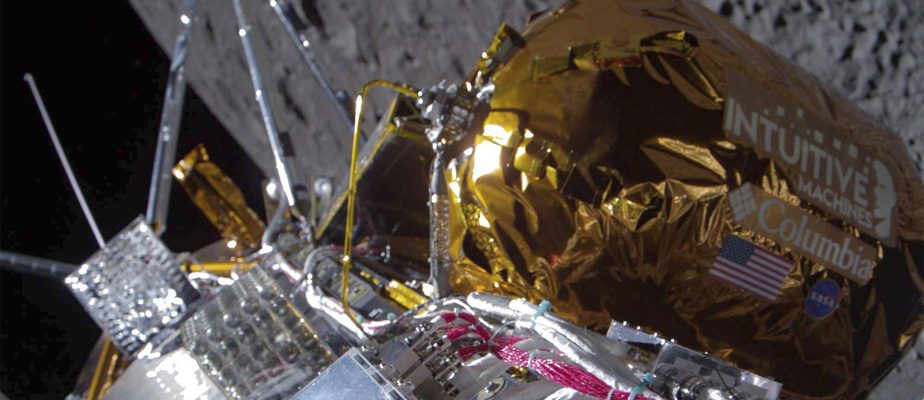The American private moon lander Odysseus successfully landed on the moon Thursday evening. This is the first American moon landing since the Apollo 17 mission in 1972.
What there is to know
- The American private moon lander Odysseus achieved the closest controlled moon landing to the lunar South Pole, but it was difficult to establish whether it was functional.
- Seven cameras from the Ontario firm Canadensys are on boardOdysseus.
- The moon landingOdysseus follows the failure of the private American Peregrine mission in January.
However, we had to wait two hours for confirmation that the Nova-C model lander was functional. The control room of Intuitive Machines, of Houston, reported after the moon landing an abnormally weak signal from the lunar lander.
“The controllers confirm thatOdysseus is standing and sending data. Right now we are working to have images,” Intuitive Machines said on X at 8:25 p.m.
Intuitive Machines and NASA nevertheless celebrated the moon landing shortly before 7 p.m. “For the first time in half a century, the United States is back on the Moon,” Bill Nelson, the head of NASA, said by video.
“I know it’s been nerve-wracking, but we’re on the surface, and we can transmit,” Intuitive Machines CEO Steve Altemus said shortly before 7 p.m. during the live broadcast of communications from the control room. The broadcast stopped immediately after this verdict, to prevent the whole world from witnessing the difficulties of the mission firsthand.
Previously, Mr. Altemus had stated thatOdysseus “wasn’t dead.”
Odysseus, which carries seven cameras from the Ontario firm Canadensys, touched the lunar ground in the Malapert A crater, less than 300 km from the South Pole. It is the closest moon landing to the South Pole, whose attraction is due to its stocks of icy water.
The Indian mission Chandrayaan-3, which previously held this record, landed last August 600 km from the South Pole. In 2008, the Indian mission Chandrayaan-1 sent an “impactor” to crash directly into the South Pole, which was a first.

INFOGRAPHICS THE PRESS
Moon landing areaOdysseus
The moon landing schedule was changed several times Thursday due to problems with the navigation instruments on the Nova-C lander from Intuitive Machines of Houston. An experimental NASA laser system, which was to be tested during the mission, had to be used for the moon landing.
The precision of the moon landing was vital: Malapert A has a diameter of just 24 km.
International Lunar Observatory
This success follows the failure of the private Peregrine mission in January. Peregrine experienced a fuel leak shortly after launch and never reached lunar orbit. Two private lunar landers, the Israeli Beresheet in 2019 and Japanese Hakuto-R in 2022, traveled to the Moon, but did not land correctly.
Odysseus was launched on February 15. Its mission to the Moon is expected to last a week.

PHOTO RAQUEL NATALICCHIO, ASSOCIATED PRESS
The Intuitive Machines team celebrated the successful moon landing Thursday in Houston
Two of Canadensys’ cameras will be used to test the prototype of the International Lunar Observatory (ILO-X), an NGO project bringing together astronomers from several countries. One of the cameras has a narrow field to observe the Milky Way away from the Sun’s light, the other a wide field to clearly observe the surroundings on the Moon.
Three other cameras installed on the mini-probe EagleCam were dropped by Odysseus shortly before the moon landing, at an altitude of 30 meters. They were to film the arrival of the lander on the lunar surface.
EagleCam is a cube with 180 degree cameras on each side. The objective is for them to survive the shock of their moon landing without propulsion. One of them is necessarily facing upwards.
Christian Sallaberger, CEO of Canadensys
EagleCam is a project of Embry-Riddle Aeronautical University in Florida. This is the first time that a moon landing can be photographed from the lunar surface.
Images from Canadensys cameras will not be sent with priority. “The important thing at the moment is the transfer of data from the lander, then the scientific data,” says Mr. Sallaberger. Then, depending on the bandwidth, we may be able to send low resolution images. Intuitive Machines, the teamEagleCam and the ILO-X astronomers will choose the most interesting ones to send higher resolution versions as bandwidth becomes available.
Astromobile vehicle
Canadensys will also provide a multispectrum camera for another Intuitive Machines mission, which will inspect a region of the Moon with magnetic anomalies called Reiner Gamma in 2025. And a rover vehicle financed by the Canadian Space Agency (CSA), which is due to leave for the Moon in 2026 or later, will also be equipped with cameras from Canadensys, which is the prime contractor for the vehicle project.
Intuitive Machines will receive more than $700 million from NASA for three lunar missions with its Nova-C lander model, including this one. The Odysseus mission must test several systems essential to a lunar base, including a navigation system and a fuel gauge in zero gravity.
Nova-C uses a unique methane propulsion system, which requires particularly low temperatures. This is a technology developed by NASA in 2010 as part of a project called Morpheus. The advantage of methane is that it could be made on the Moon from ice.
Learn more
-
- US$118 million
- Odysseus Mission Cost
Source: NASA
